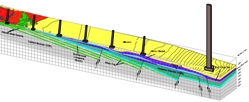
GROUND TRUTH
Fig 6 A ground model of the Southern Marine Area, showing upper and lower fluvio-glacial deposits, faulting and intrusions.
Fig 4 illustrates a ground model interpreted from preliminary studies and the GI findings from 2008 and 2009. The geology encountered was broadly as expected from the preliminary studies. However, the following key pieces of geological information did emerge from the five main areas of the site:
In the Southern Land Area, the Calders Member was found to consist of Port Neuk Sandstone, which is now known to extend beneath the main crossing’s south abutment and first viaduct pier, 500m further north than shown on the 1:50,000 geological map (Fig 3). Unlike other areas of the Forth Valley
7, fluvioglacial deposits in Southern and Northern Marine Areas occur at two distinct levels of variable extent: an upper deposit resting on glacial till, and a lower deposit, below the till, resting on bedrock. The upper deposits are thought to represent sands and gravels of meltwater outwash terraces deposited during the retreat of the Highland Ice Sheet. The lower are thought to be the remnant of a previous glacial event.
The alkali dolerite sill, cropping out on the southern shore, extends beneath the Southern Marine Area as a series of sills rather than the single continuous dolerite mass encountered on land. These sills thin northwards such that very little dolerite was encountered beneath the South Tower location. These multiple thin dolerite intrusions possibly represent the advancing (finger-like) sill-front.
In places, the alkali dolerite has been significantly altered into an aggregate of calcium, magnesium and iron carbonates with kaolin and muscovite - referred to in the published literature as ‘white trap’. The alteration probably occurs through interaction of the magma with hydrocarbon-rich volatiles distilled from oil shales, carbonaceous mudstones or coals during intrusion. This type of alteration is most pronounced where dolerite sills are thin.
As part of a collaboration instigated by the JAJV, several cores were sent to BGS in Edinburgh to aid in the correct identification of strata. The core from the Central Marine Area penetrated through the quartz-dolerite intrusion into underlying sedimentary rock, which was expected to be the West Lothian Oil Shale Formation. However BGS identified it as the Sandy Craig Formation, which is now known to extend below the central tower at least 500m further south than shown on the 1:50,000 geological map (Fig 3). The sedimentary units of the Sandy Craig Formation encountered in the Central and Northern Marine areas do not appear to be from the same horizon; though whether higher or lower in the stratigraphy is not clear.